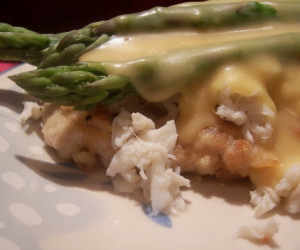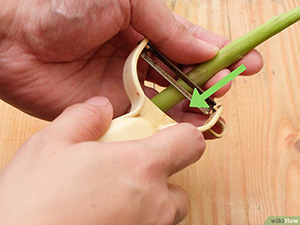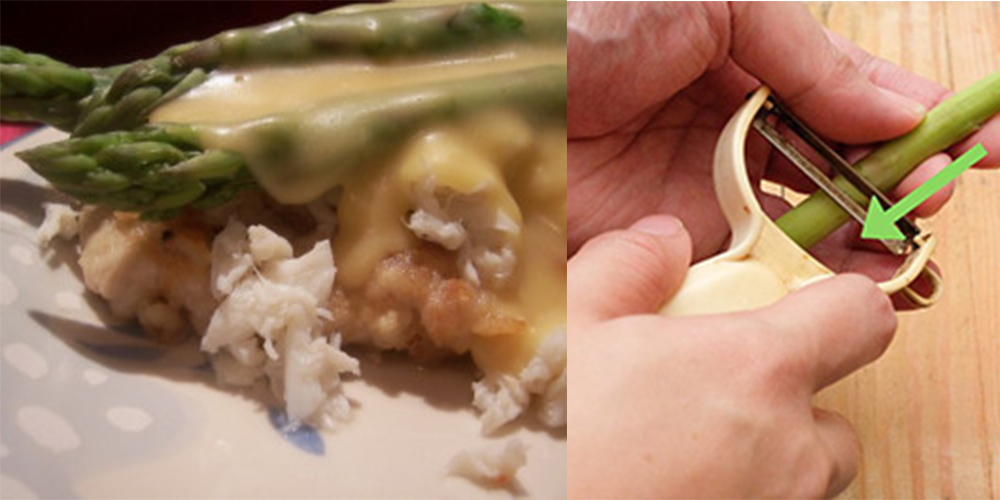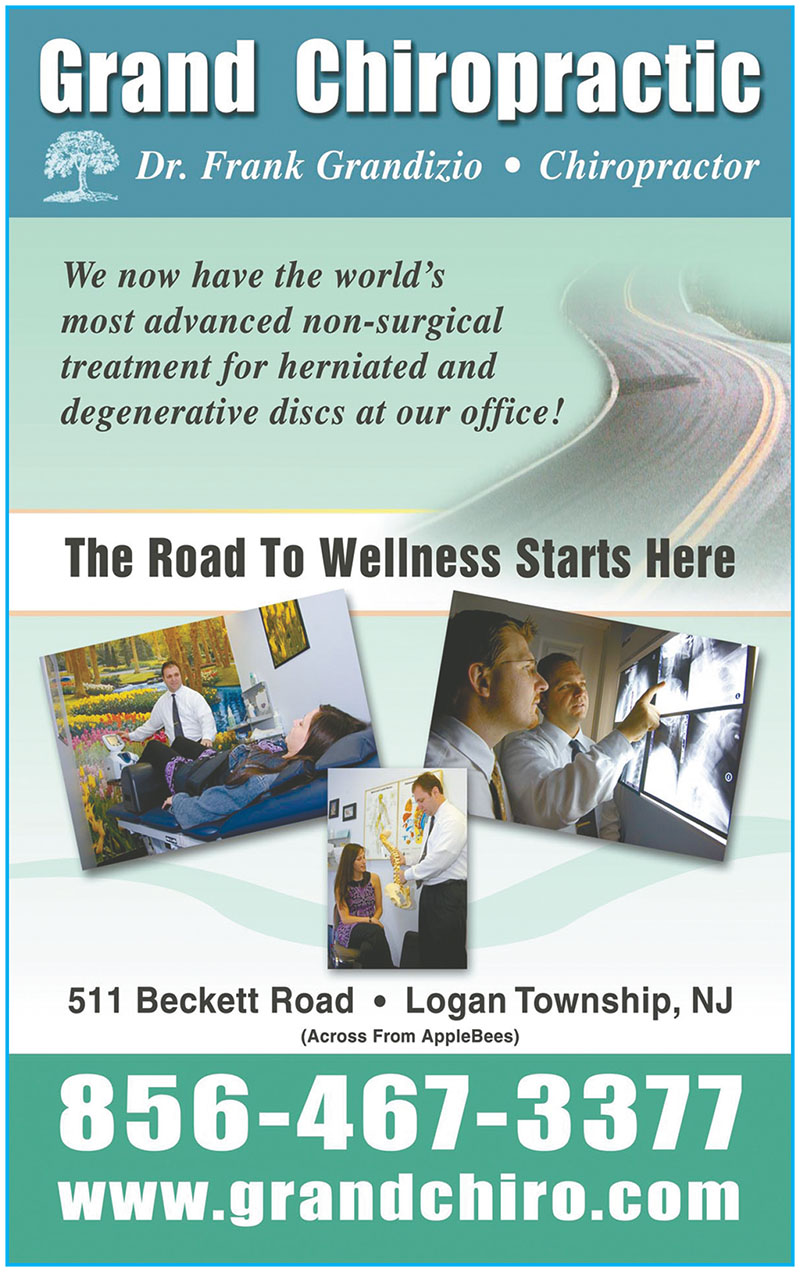It’s finally springtime. This means flowers, and leaves on the trees. But what it means the most for me, is asparagus.
Fun local facts about asparagus: an Asparagus Festival Celebration will be held on Saturday, May 14 in Mullica Hill to celebrate the Centennial of the first air shipment of produce in America when 1,000 pounds of asparagus was transported by plane from Mullica Hill to Boston.
And according to published information, Edgar Hurff of Swedesboro, who owned the largest privately owned processing plant in the world (now Del Monte in Swedesboro) was the first to process canned asparagus in the eastern United States.
With such deep roots in the history of the vegetable, why not celebrate it with one of my favorite asparagus recipes.
And if you don’t enjoy getting the added bonus of some gritty local farm soil in with a bite or your asparagus, I’ve added some cleaning tips.
CHICKEN OSCAR WITH LEMON CHIVE SAUCE

2 boneless, skinless chicken breast halves
3 ozs. jumbo lump crab meat
1/2 small onion, chopped
1/2 medium tomato, chopped
10 thin asparagus
2 Tbsp. flour
1 Tbsp. oil
1 tsp. butter
1/4 tsp. black pepper
1/4 tsp. salt
• In medium saucepan, bring salted water to boil. Add asparagus and boil until tender but NOT SOFT. Drain. Set aside until needed.
• Pound chicken between sheets of plastic wrap to 1/2” thickness. On a medium plate mix flour with the salt and pepper. Dredge chicken to coat, patting off any excess.
• In medium flying pan over medium heat, warm the butter and oil. Sauté chicken breasts on both sides, about 3 minutes per side. Remove chicken when cooked and set aside. Keep warm. Add onion to skillet and sauté until soft (about 4 minutes). Increase heat to high. Add tomato and sauté until most of moisture has evaporated. Lower heat to low and add crab meat. Toss gently just until hot.
• To serve, set one chicken breast on each plate. Arrange asparagus on top of each. Spoon crab mixture over asparagus. Top with lemon chive sauce.
LEMON CHIVE SAUCE
1 Tbsp. butter
2 Tbsp. lemon juice
5 Tbsp. whipped cream cheese
1 Tbsp. milk
1 Tbsp. chopped fresh chives (1 tsp. dried)
• In small pan over low heat, melt the butter with lemon juice. Whisk in cream cheese, milk and chives till smooth.
OPTION: Serve chicken over a pile of mashed potatoes, then top with asparagus, crab, and sauce.
THREE WAYS TO CLEAN ASPARAGUS
Method One of Three: Rinsing
1. Hold the asparagus under running water. Take a bunch of asparagus and remove the rubber band that holds the stalks together. Turn on cool water and rinse the asparagus stalks under the water. Rinse the thinnest end where sand and grit can hide really well. If the asparagus seems very dirty, you can use your thumb and forefinger to loosen sand or grit. You can also wash the stalks individually to remove the dirt.
2. Snap off the tough ends of the asparagus. Turn off the water and set the cleaned asparagus on a work surface. Take one asparagus stalk and hold the middle of it with one hand. Use the thumb and forefinger of your other hand to hold the tough end of the stalk. Gently bend the asparagus stalk down, so the tough end snaps off. Snap off the ends from all of the cleaned asparagus. If you’re using thick asparagus, you may need to snap off a few inches from the bottom of the stalk. Thinner asparagus may only need to be trimmed by an inch.
3. Dry the asparagus between kitchen towels. Lay a kitchen towel open on your work surface. Spread the cleaned asparagus on the towel in a single layer. Lay another kitchen towel over the asparagus and rub it gently across the asparagus. They should dry as they roll between the 2 towels.
Method Two of Three: Blanching

1. Bring a pot of water to boil. Get out a large pot and fill it three-quarters full with water. Put a lid on the pot and set it on the stove. Turn the heat to high and bring the water to a boil.
2. Dip the asparagus in the boiling water. Use tongs to hold several asparagus stalks. Lower the asparagus into the boiling water and hold them there for a few seconds. If there are any small leaves on the stalks, they should wilt a little. Lift the asparagus out of the boiling water and continue to dip the rest of the asparagus. The hot water should open the tender tips a little so grit wash out easily.
3. Rinse the asparagus under cool water. Set the asparagus in a strainer or colander and set it in the sink. Run cool water over the asparagus to stop it from cooking. The cold water will also help the asparagus keep its bright color.
If you’ll be coating the asparagus in oil before cooking it, consider drying the asparagus between a kitchen towel.
4. Use the asparagus or store it in the refrigerator. Use the cleaned asparagus in your recipes. You can bake the asparagus in the oven, sauté it on the stove top, or grill them. You can also store the cleaned asparagus in the refrigerator for 3 to 4 days. To store the asparagus, wrap the trimmed ends in a damp paper towel so they don’t dry out. Place the asparagus bunch upright in a jar or bottle.
Method Three of Three: Shaving

1. Rinse the asparagus under cold water. Gather the stalks of asparagus and hold them under the faucet. Wash the asparagus with cold water and ensure that the grit at the tender tip of the stalks is rinsed away.If the asparagus is slick or hard to handle, you can dry it with a kitchen towel before you peel it.
2. Use a vegetable peeler to peel the asparagus. Move the rinsed asparagus to a work surface. Take a vegetable peeler and peel each stalk from the base of the tender tip to the tough end. Avoid peeling off the tender tip that you already washed. Repeat this for all of the asparagus. Remove only the thin, outer layer of the asparagus or you may remove too much of the stalk.
3. Snap off the tough ends. Hold one asparagus stalk by the middle of one hand. Use the thumb and forefinger of your other hand to hold the tough end of the stalk. Press the asparagus stalk down, so the tough end snaps off where the woody end meets the tender part of the asparagus. Snap off the ends from all of the cleaned asparagus. If you’re using thick asparagus, you may need to snap off a few inches from the bottom of the stalk. Thinner asparagus may only need to be trimmed by an inch. If a thick stalk of asparagus isn’t snapping easily, you may have to move your fingers closer to the center of the stalk so several inches snap off.
4. Use the shaved asparagus in a recipe. You can use the cleaned asparagus in recipes that call for tender asparagus. Because these stalks have been trimmed and may burn easily, you should avoid tossing them on the grill. Consider sautéing them or roasting them in the oven.
You can also refrigerate the shaved asparagus for 3 to 4 days before you use the stalks. Wrap the trimmed ends in a damp paper towel to prevent them from drying out, then set the asparagus bunch upright in a jar or bottle.
by Karen E. Viereck, Editor/Publisher







